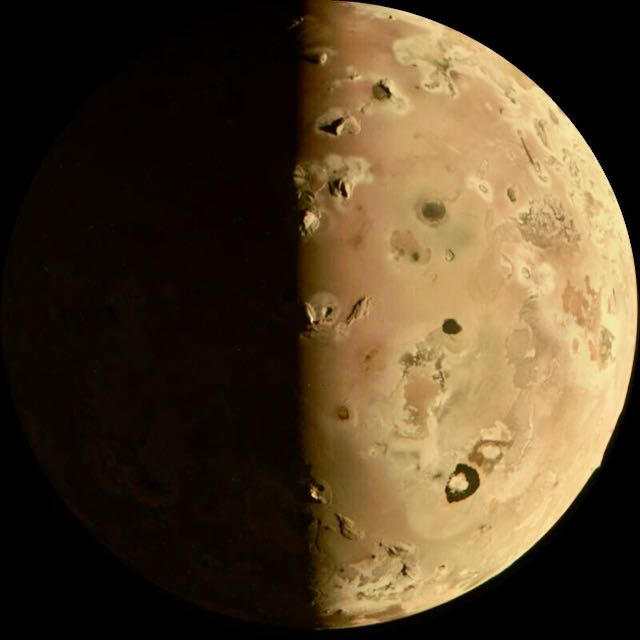
A glimpse of the cosmic web
Astronomers speak of the cosmic web as the most fundamental, large-scale structure of our universe. They picture it as a network of filaments and voids – spanning untold billions of light-years – whose skeleton is formed primarily by invisible dark matter. And, although we can’t see it, astronomers estimate that some 85% of all matter in our universe is dark matter. So it seems logical, but how can we know for sure that the cosmic web is even there?
The answer is that we see dark matter’s influence on other components of our universe. In the case of this image, we see a bridge of gas stretched between two distant galaxies in the early universe. The European Southern Observatory (ESO) shared this image on January 29, 2025. They said it represents the “clearest image yet” of a filament of the cosmic web.
The researchers published their peer-reviewed study of this image on January 29, in the journal Nature Astronomy.
Bridging 2 galaxies
The starfield in the background of the image is from the Hubble Space Telescope. But look more closely. You might be able to see a fuzziness to many of these “stars,” which – except for a few bright spiky objects – aren’t stars at all, but instead distant galaxies. The purple color is an overlay of the location of gas that has clumped together, thanks to the influence of dark matter.
The two larger concentrations center on galaxies, while the thin filament between them represents a bridge of material.
This filament of the cosmic web is huge! It’s some 3 million light-years long. The researchers found this faint bridge of glowing gas by making 150 hours of observations with the MUSE instrument on ESO’s Very Large Telescope in Chile.
Lead author Davide Tornotti of the University of Milano-Bicocca in Italy led the team that conducted the high-definition imaging of the filament. The filament was located at a redshift of what astronomers call z = 3, which is equivalent to a distance from Earth of more than 11 billion light-years.
A prediction of cold dark matter theory
The discovery is a boost to the prevailing model used by scientists to understand how our universe works and fits together. That model is called the Lambda CDM model, for Lambda cold dark matter. It’s a mathematical model, integrated into the Big Bang theory. The model suggests that dark matter consists of particles moving much more slowly than the speed of light. Many (but not all) astronomers feel that this still-hypothetical type of dark matter is the best fit with what we see in the universe so far. It explains how the smooth early cosmos turned into the clumps and then structures – such as galaxies – that we see today.
One long-standing prediction of the Lambda CDM model involves the idea of filaments between the dark matter halos surrounding galaxies. And this is just what this new image is thought to show. A press release that described it said:
In the early universe, filaments of dark matter could have created a large web that entangled gas through their gravitational pull. Once gas accumulated at the intersection between filaments, it would have provided the fuel necessary to form galaxies.
The researchers said their image:
opens a new avenue to constrain the physical properties of the cosmic web and to trace the distribution of dark matter on large scales.
Bottom line: A new image from ESO’s Very Large Telescope provides what these astronomers called “our clearest view yet” of a filament in the cosmic web.
Source: High-definition imaging of a filamentary connection between a close quasar pair at z = 3
The post A filament of the cosmic web! Clearest image yet first appeared on EarthSky.
from EarthSky https://ift.tt/4iu8kdF

A glimpse of the cosmic web
Astronomers speak of the cosmic web as the most fundamental, large-scale structure of our universe. They picture it as a network of filaments and voids – spanning untold billions of light-years – whose skeleton is formed primarily by invisible dark matter. And, although we can’t see it, astronomers estimate that some 85% of all matter in our universe is dark matter. So it seems logical, but how can we know for sure that the cosmic web is even there?
The answer is that we see dark matter’s influence on other components of our universe. In the case of this image, we see a bridge of gas stretched between two distant galaxies in the early universe. The European Southern Observatory (ESO) shared this image on January 29, 2025. They said it represents the “clearest image yet” of a filament of the cosmic web.
The researchers published their peer-reviewed study of this image on January 29, in the journal Nature Astronomy.
Bridging 2 galaxies
The starfield in the background of the image is from the Hubble Space Telescope. But look more closely. You might be able to see a fuzziness to many of these “stars,” which – except for a few bright spiky objects – aren’t stars at all, but instead distant galaxies. The purple color is an overlay of the location of gas that has clumped together, thanks to the influence of dark matter.
The two larger concentrations center on galaxies, while the thin filament between them represents a bridge of material.
This filament of the cosmic web is huge! It’s some 3 million light-years long. The researchers found this faint bridge of glowing gas by making 150 hours of observations with the MUSE instrument on ESO’s Very Large Telescope in Chile.
Lead author Davide Tornotti of the University of Milano-Bicocca in Italy led the team that conducted the high-definition imaging of the filament. The filament was located at a redshift of what astronomers call z = 3, which is equivalent to a distance from Earth of more than 11 billion light-years.
A prediction of cold dark matter theory
The discovery is a boost to the prevailing model used by scientists to understand how our universe works and fits together. That model is called the Lambda CDM model, for Lambda cold dark matter. It’s a mathematical model, integrated into the Big Bang theory. The model suggests that dark matter consists of particles moving much more slowly than the speed of light. Many (but not all) astronomers feel that this still-hypothetical type of dark matter is the best fit with what we see in the universe so far. It explains how the smooth early cosmos turned into the clumps and then structures – such as galaxies – that we see today.
One long-standing prediction of the Lambda CDM model involves the idea of filaments between the dark matter halos surrounding galaxies. And this is just what this new image is thought to show. A press release that described it said:
In the early universe, filaments of dark matter could have created a large web that entangled gas through their gravitational pull. Once gas accumulated at the intersection between filaments, it would have provided the fuel necessary to form galaxies.
The researchers said their image:
opens a new avenue to constrain the physical properties of the cosmic web and to trace the distribution of dark matter on large scales.
Bottom line: A new image from ESO’s Very Large Telescope provides what these astronomers called “our clearest view yet” of a filament in the cosmic web.
Source: High-definition imaging of a filamentary connection between a close quasar pair at z = 3
The post A filament of the cosmic web! Clearest image yet first appeared on EarthSky.
from EarthSky https://ift.tt/4iu8kdF




















